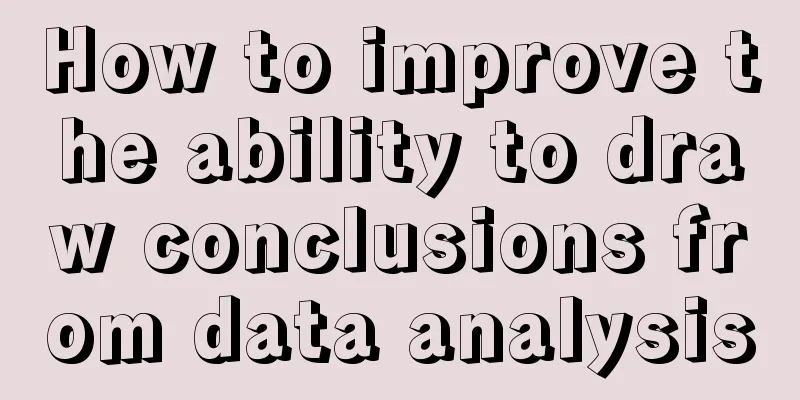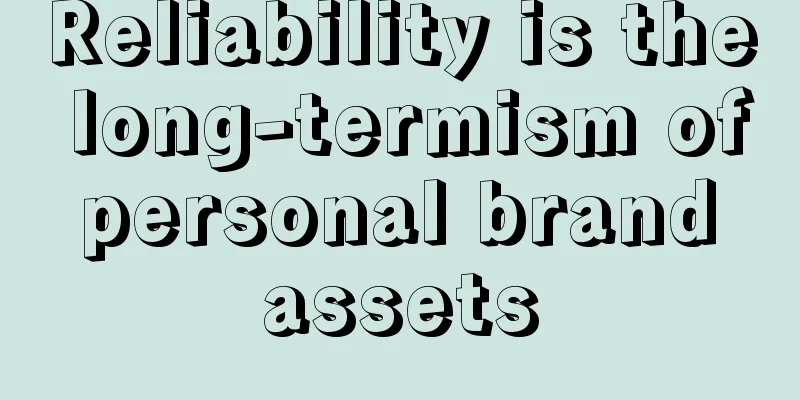How to improve the ability to draw conclusions from data analysis

A friend asked me a question: How to improve the ability to draw conclusions from data analysis? Data analysis is not just about piling up data, drawing charts, and making reports. The real core of data analysis lies in how to extract valuable conclusions from massive data. So, today I will share with you three methods to help you improve your ability to draw conclusions from data analysis. 1. Determine the analysis objectivesFirst, we need to clarify the goal of data analysis. What is the goal of data analysis? It is to solve practical problems. If you do not analyze according to the goal, you may draw some conclusions, but what is the use of these conclusions? Even the goal of the question itself is wrong. The business person wants to use your analysis to shift the blame to him. This kind of demand takes up your energy, and the conclusion is useless, so you naturally cannot improve. So, how should we determine the analysis objectives? Before we start data analysis, we need to understand what problem we want to solve. Specifically, we can identify the problem from the following aspects:
Often, data analysis skills cannot be improved because one does not know what the analysis is used for. If one does not know what one is doing, one cannot accumulate and improve. Goal-oriented thinking is one of the most important thinking styles for data analysts, and we must develop a habit of conditioned reflex thinking. Friends who are familiar with me know that if someone asks me a question, my first response is usually the same: "What is your goal?" 2. Improve business awarenessThe second method is to enhance business awareness . A very important reflection of data analysis ability is whether you can use data to draw valuable judgments about the business. If you don't understand the business, then you can only talk about numbers, a pure numbers game, and the conclusion you will draw is either that the conversion rate is too low and needs to be increased, or that the GMV progress is behind the target and you need to make 10 million more. Such a conclusion is far from being implemented in practice. Another possibility is that you don’t understand the business and come to some completely wrong conclusions. For example, if the conversion rate of a certain channel is particularly high, the data analyst may recommend increasing the delivery of this channel. The actual situation may be that this channel is very niche and has already reached its ceiling. Or, if the future sales are predicted based on historical data, but the impact of seasonality is completely unknown, the calculated results may be completely unrealistic. So, how should we improve business awareness?
It is difficult to improve business awareness because data analysts generally do not have direct contact with the business, and their business awareness itself is relatively vague. It is recommended to learn more business knowledge, and it is better to have theoretical guidance combined with practice than to summarize it by yourself. 3. Continuous learning and reviewThe third way to improve the ability to draw conclusions from data analysis is to keep learning and improving. Data analysis is an iterative process, in which we need to constantly learn new knowledge, skills and methods to improve our abilities. Learning ability is the core ability that makes a difference between people in the workplace. The following learning methods are recommended. 1. Systematic learningAlthough people in the workplace are encouraged to learn in a fragmented way, it is only possible to learn the basics. It is okay to learn some skills and tools in a fragmented way, and you can use them immediately after learning. However, data analysts need to have the ability to think deeply, and they need to leave enough time to digest the knowledge repeatedly after learning, so systematic learning becomes more important. So I suggest you try to choose systematic courses or resources for learning, so that you can better master the knowledge system. 2. Take notesDuring the learning process, develop the habit of taking notes. Although this habit may seem like a skill that only students need to master, it is still highly recommended that everyone develop the habit of taking notes. Anyway, electronic notes are very convenient nowadays, and you can even input them by voice. The skills required of a data analyst are very scattered, including knowledge in different fields such as statistics, tools, methods, technology, thinking, business, etc. It is difficult to remember all of them without the help of notes. After encountering a problem, I often think about the knowledge needed to solve the problem, and then go back to look at the corresponding notes. 3. ReviewLearning without thinking is useless, thinking without learning is dangerous. In daily work, we usually think about how to do this job well, commonly known as bowing our heads to pull the cart . In addition to bowing our heads to pull the cart, we also have to look up and see the road. After having some analyzed cases, we should summarize these experiences in time, combine these experiences with the knowledge learned, and extract our own things. 4. Communicate with othersActively participate in industry exchange activities and share experiences and insights with peers. This not only broadens your knowledge, but also helps build relationships and improve communication skills. I have participated in several offline gatherings, and the perspectives provided by people from different industries, positions and levels have given me a lot of new thoughts on the job characteristics and value of data analysts. IV. SummaryTo summarize, to improve our ability to draw conclusions from data analysis, we need to do the following three things: determine analysis goals, enhance business awareness, and continue to learn and review. Finally, sometimes you find it difficult to do these three things. Because the boss never explains the background of the tasks he assigns, and you are just a tool for collecting data. The workload is too slow and you don't have time to think. This situation is really difficult to solve. Data analysts are very picky about the environment. A good environment will lead to virtuous cycle of development, while a bad environment will lead to a continuous vicious cycle. In this case, it is difficult to change the environment. If the salary is okay, you can stay in this environment. If the job itself is not ideal, then don't think about changing the environment, it is too difficult. You can go to a new good environment. Author: Jason Source: WeChat public account "Sanyuanfangcha (ID: sanyuanfangcha)" |
<<: How to do industry research on Xiaohongshu? A must-read series before operating Xiaohongshu!
>>: How to conduct operational data analysis?
Recommend
WeChat stores, the end is a crash
The launch of WeChat Stores is seen as the rekindl...
Talk about advertising content: Only people can impress people
The combination of advertising and content is a re...
Will advertisers’ marketing budgets continue to decline in 2024?
In the past two years, the global advertising mark...
How much does Amazon Japan charge in monthly rent? How does Amazon operate?
With the rapid development of e-commerce, Amazon, ...
Do I need to fill in the tracking number for products shipped by Amazon?
For some small and medium-sized sellers, Taobao is...
What I witnessed at ChinaJoy 2024: Top game developers competed against each other, and new Internet giants joined the show
ChinaJoy 2024 was unprecedentedly grand, with top ...
Meituan’s new card to fight back against TikTok
On April 18, in an internal email released by Meit...
Pinduoduo Temu headquarters was besieged by merchants, a crusade against "refund only"?
Pinduoduo's cross-border e-commerce platform T...
How to fill in the Amazon market price? What is the method?
Amazon merchants need to set the price of goods wh...
Niche content, pioneer groups, lost creation, let's talk about talk shows from the perspective of content
As a recent hot topic, the Xiaoguo House incident ...
How did “Zibo BBQ” become popular?
In the past month, "Zibo BBQ" has become...
The college entrance examination copywriting you want is here!
The college entrance examination is coming, are yo...
One video gained 140,000 followers. This track is making rapid progress on Xiaohongshu
A video about dismantling a home gained 140,000 fo...
Labels VS data indicator system, this article explains it very clearly!
This article introduces the concepts and applicati...
Building an anti-fragile growth model, the global content system of consumer goods and the second growth curve
In today's highly competitive consumer goods m...









